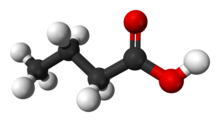ബ്യൂട്ടിറിക്ക് ആസിഡ്
ബ്യൂട്ടിറിക്ക് ആസിഡ് (പുരാതന ഗ്രീക്ക്: βούτῡρον, "വെണ്ണ" എന്ന് അർത്ഥം) ബ്യൂട്ടനോയിക് ആസിഡ് എന്ന പേരിലും അറിയപ്പെടുന്നു.[4]CH3CH2CH2-COOH എന്ന ഘടനയുള്ള ഒരു കാർബോക്സിലിക് ആസിഡ് ആണിത്. ബ്യൂട്ടിറിക്ക് ആസിഡിലെ ലവണങ്ങളും എസ്റ്ററുകളും ബ്യൂട്ടിറേറ്റ് അല്ലെങ്കിൽ ബ്യൂട്ടനോയേറ്റ്സ് എന്ന് അറിയപ്പെടുന്നു. ബ്യൂട്ടിറിക്ക് ആസിഡ് മൃഗങ്ങളുടെ കൊഴുപ്പ്, സസ്യ എണ്ണ,[4] എരുമപ്പാൽ, മുലപ്പാൽ,[8] വെണ്ണ, പാർമേഷൻ ചീസ് അനെയ്റോബിക് ഫെർമെൻറേഷൻ കൊണ്ടുണ്ടാകുന്ന ഉത്പ്പന്നം (വൻകുടലിലെയും ശരീരത്തിൻറെയും ഗന്ധത്തിലുൾപ്പെടുന്നു) എന്നിവയിലെല്ലാം കാണപ്പെടുന്നു.[4][9] ബ്യൂട്ടിറിക്ക് ആസിഡിന് വെണ്ണയെപ്പോലെയാണ് രുചിയെങ്കിലും ഒരു അസുഖകരമായ ഗന്ധവും ഉണ്ട്.[4]ഈ ഗന്ധം തിരിച്ചറിയാൻ കഴിവുള്ള സസ്തനികളിൽ നായക്ക് ഒരു ബില്യൻറെ10 ഭാഗം തിരിച്ചറിയാൻ കഴിയും. എന്നാൽ മനുഷ്യർക്ക് ഇത് ഒരു മില്ല്യൻറെ 10 ഭാഗം അളവിൽ മാത്രമേ തിരിച്ചറിയാൻ കഴിയുകയുള്ളൂ. ഭക്ഷ്യ ഉൽപന്നത്തിൽ, ഇത് ഒരു സുഗന്ധവ്യഞ്ജന ഘടകമായി ഉപയോഗിക്കുന്നു.[4]
| |||

| |||
| Names | |||
|---|---|---|---|
| Preferred IUPAC name
Butanoic acid[1] | |||
| Other names | |||
| Identifiers | |||
3D model (JSmol)
|
|||
| ChEBI | |||
| ChEMBL | |||
| ChemSpider | |||
| DrugBank | |||
| ECHA InfoCard | 100.003.212 | ||
| EC Number |
| ||
| KEGG | |||
| MeSH | {{{value}}} | ||
PubChem CID
|
|||
| RTECS number |
| ||
| UNII | |||
| UN number | 2820 | ||
CompTox Dashboard (EPA)
|
|||
| InChI | |||
| SMILES | |||
| Properties | |||
| തന്മാത്രാ വാക്യം | |||
| Molar mass | 0 g mol−1 | ||
| Appearance | Colorless liquid | ||
| Odor | Unpleasant, similar to vomit or body odor | ||
| സാന്ദ്രത | 1.135 g/cm3 (−43 °C)[2] 0.9528 g/cm3 (25 °C) | ||
| ദ്രവണാങ്കം | |||
| ക്വഥനാങ്കം | |||
| Sublimes at −35 °C ΔsublH | |||
| Miscible | |||
| Solubility | Slightly soluble in CCl4[4] Miscible with ethanol, ether | ||
| log P | 0.79[4] | ||
| ബാഷ്പമർദ്ദം | 0.112 kPa (20 °C)[4] 0.74 kPa (50 °C) 9.62 kPa (100 °C)[3] | ||
Henry's law
constant (kH) |
5.35·10−4 L·atm/mol[4] | ||
| അമ്ലത്വം (pKa) | 4.82[4] | ||
| -55.10·10−6 cm3/mol | |||
| Thermal conductivity | 1.46·105 W/m·K | ||
| Refractive index (nD) | 1.398 (20 °C) | ||
| വിസ്കോസിറ്റി | 1.814 cP (15 °C)[5] 1.426 cP (25 °C)[4] | ||
| Structure | |||
| Monoclinic (−43 °C)[2] | |||
| C2/m[2] | |||
a = 8.01 Å, b = 6.82 Å, c = 10.14 Å[2] α = 90°, β = 111.45°, γ = 90°
| |||
| 0.93 D (20 °C)[5] | |||
| Thermochemistry | |||
| Std enthalpy of formation ΔfH |
−533.9 kJ/mol[3] | ||
| Std enthalpy of combustion ΔcH |
2183.5 kJ/mol[3] | ||
| Standard molar entropy S |
222.2 J/mol·K[5] | ||
| Specific heat capacity, C | 178.6 J/mol·K[3][4] | ||
| Hazards | |||
| Safety data sheet | External MSDS | ||
| GHS pictograms |  [7] [7]
| ||
| GHS Signal word | Danger | ||
| H314[7] | |||
| P280, P305+351+338, P310[7] | |||
| Flash point | {{{value}}} | ||
| Explosive limits | 2.2–13.4%[4] | ||
| Lethal dose or concentration (LD, LC): | |||
LD50 (median dose)
|
2000 mg/kg (oral, rat) | ||
| Related compounds | |||
| Other anions | Butyrate | ||
Except where otherwise noted, data are given for materials in their standard state (at 25 °C [77 °F], 100 kPa).
| |||
ഇതും കാണുക
തിരുത്തുകഅവലംബം
തിരുത്തുക This article incorporates text from a publication now in the public domain: Chisholm, Hugh, ed. (1911). "Butyric Acid". എൻസൈക്ലോപീഡിയ ബ്രിട്ടാനിക്ക (11th ed.). കേംബ്രിഡ്ജ് സർവകലാശാല പ്രസ്സ്. {{cite encyclopedia}}: Invalid |ref=harv (help)
- ↑ 1.0 1.1 "Front Matter". Nomenclature of Organic Chemistry : IUPAC Recommendations and Preferred Names 2013 (Blue Book). Cambridge: The Royal Society of Chemistry. 2014. p. 746. doi:10.1039/9781849733069-FP001. ISBN 978-0-85404-182-4.
- ↑ 2.0 2.1 2.2 2.3 Strieter, F. J.; Templeton, D. H. (1962). "Crystal structure of butyric acid". Acta Crystallographica. 15 (12): 1240–1244. doi:10.1107/S0365110X6200328X.
{{cite journal}}: Unknown parameter|name-list-format=ignored (|name-list-style=suggested) (help) - ↑ 3.0 3.1 3.2 3.3 3.4 Butanoic acid in Linstrom, P.J.; Mallard, W.G. (eds.) NIST Chemistry WebBook, NIST Standard Reference Database Number 69. National Institute of Standards and Technology, Gaithersburg MD. http://webbook.nist.gov (retrieved 13 June 2014)
- ↑ 4.00 4.01 4.02 4.03 4.04 4.05 4.06 4.07 4.08 4.09 4.10 4.11 4.12 4.13 "Butyric acid, PubChem CID 264". PubChem, US National Library of Medicine. 24 November 2018. Retrieved 29 November 2018.
- ↑ 5.0 5.1 5.2 "butanoic acid". Chemister.ru. 2007-03-19. Archived from the original on 2016-05-09. Retrieved 2016-05-09.
- ↑ Lide, David R., ed. (2009). CRC Handbook of Chemistry and Physics (90th ed.). Boca Raton, Florida: CRC Press. ISBN 978-1-4200-9084-0.
- ↑ 7.0 7.1 7.2 7.3 7.4 Sigma-Aldrich Co., Butyric acid. Retrieved on 13 June 2014.
- ↑ McNabney, S. M.; Henagan, T. M. (2017). "Short Chain Fatty Acids in the Colon and Peripheral Tissues: A Focus on Butyrate, Colon Cancer, Obesity and Insulin Resistance". Nutrients. 9 (12): 1348. doi:10.3390/nu9121348. PMC 5748798. PMID 29231905.
{{cite journal}}: CS1 maint: unflagged free DOI (link) - ↑ Morrison, D. J.; Preston, T. (2016). "Formation of short chain fatty acids by the gut microbiota and their impact on human metabolism". Gut Microbes. 7 (3): 189–200. doi:10.1080/19490976.2015.1134082. PMC 4939913. PMID 26963409.

